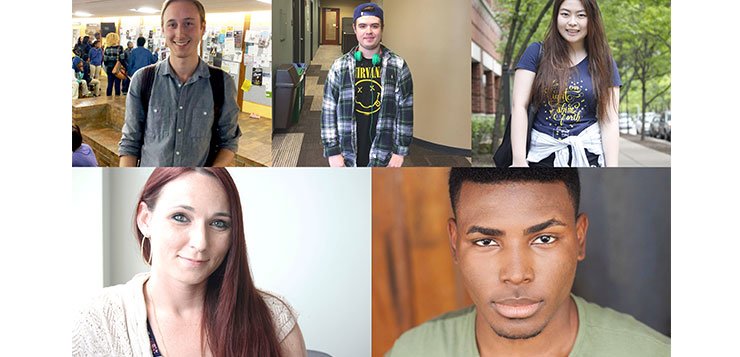 Chicago ranks sixth in international student populations, but when it comes to welcoming them into the working world, the United States’ third-largest city does not even make the top 10.
Chicago ranks sixth in international student populations, but when it comes to welcoming them into the working world, the United States’ third-largest city does not even make the top 10.
Metropolitan areas around the country attract the most foreign students in business (BMD) and science, technology, engineering and mathematics (STEM) degrees, but international DePaul graduates who manage to find employment and an extended visa by graduation are among the 53.7 percent that stay in Chicago, a recent study by the Brookings Institute found, while 46.3 percent return home either by choice or because they could not find a job.
Information technology major Jeena Dansingani left Jamaica to pursue her dream of studying in the U.S. two years ago. In her sophomore year at DePaul, Dansingani said she has to start planning now for post-graduation.
“My goal is to work here, and at least get volunteer experience working here as long as I can,” Dansingani said. “There’s nothing at home. Jamaica is a third world country. I won’t deny that. If I did get a job it wouldn’t be well paid. It wouldn’t be able to cover living expenses.”
“The goal is to really find a internship in the tech industry and be offered a full-time job — and having them sponsor me,” Dansingani said.
Students like Dansingani on an F-1 visa can do one of two internship programs during or after college with the hopes of finding a potential employer who will sponsor their application for a H-1B temporary work visa. The catch with the two intern programs, the optional practical training (OPT) and curriculum practical training (CPT) is that they have an expiration date.
STEM students have 29 months to find an employer, while non-STEM students only have a year.
Dansingani said there is a lot of pressure to find the right employer.
“First of all, the sponsorship is really expensive on (the employer’s) end,” Dansingani said.
According to immigration lawyer and DePaul alumnus, Gerry Cipolla, filement fees for H-1B sponsorship can cost anywhere between $300 and $2,500.
“You have to show them you’re better than the people that are locals or citizens,” Dansingani said. “You have to be 10 times better to show (employers) they need to have you. You have to be ahead of the game completely.”
An international student at DePaul who wished to remain anonymous to prevent backlash from their work and future internship, said he made sure to be extra prepared for a DePaul networking event with representatives from a large company. The student had to stick out to impress them, and he said that is what helped him land an internship with the company over the summer.
“They either don’t want or cannot hire international (students) because there is a company policy,” the student said. “The way to avoid that is going the other way around. The people who interviewed me were direct managers. If they liked me from the interview, it’s regardless if I’m international or not, they want to hire me.”
The student said the company’s executives never asked if he was an international student in his interview, but interviewing as an international student is a mind game.
“International students know that employers don’t like international student status, so (students) try not to bring it up,” the student said. “If they like you it doesn’t really matter.”
The Kellstadt Marketing Group at DePaul hosted an event in February for international students to learn about the post-graduation job search. Sarah Yang, from China, said she was actively looking for a job after graduation in June.
“I’m worrying about whether I can find a job. You have to find a position you want and deal with rounds of interviews,” Yang said. “I have confidence I can find an OPT, but if it doesn’t work out, I’ll go back.”
Yang said she is not planning to go back to China and she gave up a stable job in China to study and transition careers.
“Where you have better career (is where you should go),” Yang said. “For me, (the U.S.) is comfortable to work. The environment and the culture here works. I learned something from school and I have to work on it.”
Open Doors, a data collection project launched by the Institute of International Education, reported that over 886,000 international students studied in the U.S. during the 2013-2014 academic year. Illinois ranked fifth in the country for the most number of international students that year, and the University of Illinois Urbana-Champaign had the third most international students in the country with 10,843 students.
According to Open Doors data, international students contributed $1 billion to the Illinois economy in the 2011-2012 academic year. The Brookings Institute found that the 35,204 international students studying in Chicago between 2008 and 2012 paid more than $956 million in tuition and $450 million in living costs.
The U.S. Department of Commerce found that Chinese students alone contributed more than $8 billion to the U.S. economy in 2013. According to Open Doors, by the 2013-2014 academic year, Chinese students made up 31 percent of all international students in the U.S.
Of DePaul’s 1,335 total international students, 32 percent of undergraduate students and 43 percent of graduate students are from China. Saudi Arabia comes in a distant second with 7 percent of undergraduates and 9 percent of graduates, with the exception of 16.6 percent of graduates whose origin was unknown according to DePaul enrollment data.
A majority of DePaul international students enroll in the business school, and according to the Brookings Institute, over 30 percent of international students in Chicago study business, management, marketing and related support services.
The Brookings Institute conducted the study to make policy recommendations concerning international student immigration. Only 35 percent of the 85,000 allotted H-1B temporary work visas in 2010 went to former F-1 student visa holders.
“The current visa system limits the number of H-1B visas to 85,000 for private employers per year, of which 20,000 are set aside for graduates of U.S. universities,” the Brookings Institute reported.
When asked if the U.S. was welcoming to international students post-graduation, immigration lawyer Cipolla said there was room for improvement.
“I think (the U.S.) is behind the times,” Cipolla said.
The number of H-1B visas the government gives out each year was set 15-20 years ago and numbers haven’t increased because “congress can’t get along.”
“It’s that plain and simple. Back in 2007 (President George W.) Bush tried to get (immigration policy) passed. The parties shut it down. There was heavy lobbying on both sides to get it passed; Microsoft wanted it to pass, Mark Zuckerberg is trying to push it through and it’s just not getting done,” Cipolla said.
In the face of such opposition, Cipolla said students usually try to stay in the U.S., but sometimes they have no choice but to return to their home countries.
“They either pay for more tuition — tens of thousands of dollars per year — or they go back home or they try to find some creative option,” Cipolla said.




Steve Smith • Apr 5, 2015 at 11:37 pm
So all these students lied on their visa application when they certified they were only coming to the U.S. to study and would return home.
“The number of H-1B visas the government gives out each year was set 15-20 years ago and numbers haven’t increased because “congress can’t get along.””
Total baloney. The number of visas has doubled since 1998. Congress has adjusted visa numbers in 1998, 2000, and 2004.